Overview
Copywriting is the art of using words to craft a message that not only captures the attention of your target audience but also persuades them to take action. It's the creative glue that binds together a great product or service with an audience that is craving for a solution, along with the magic that transforms curiosity into interest, and interest into action.
Table of Contents
Thus, copywriting is a means to an end, and the end means increased customers, increased sales, and increased profits. A good copy has four objectives to get attention, communicate, persuade, and a call for action. In this article, you will get to know how to write copy that gets attention, communicate the message and persuade your customer to take action. So let's get started without further ado.
How to create a compelling ad copy: 7 efficient tips
1. Start with your reader
In the most simple way, how can you make the user resonate or connect with your brand? The answer is “you - orientation”. To make your copy effective and get more conversions, you need to write while keeping the focus on your customer or reader. Here, you have to get into the shoes of your reader or your consumer and picture yourself as your reader, and start evaluating your copy by asking yourself some questions:
- Does my copy resonate with my reader?
- Will the reader understand what I have written?
- Will the reader understand the terminology or any other technical jargon I have used?
- Does my copy persuade the consumer to purchase the product or take the action?
- Does the tone, and style of the writing resonate with my reader's tone and style?
A quick tip to create a persuasive copy is to always try to use the word “You” in your copy. When you do so, it would directly make the readers feel connected and convince them that the message is specifically designed for them.
For example, for a time management application, the you-oriented text could be something shown in the image below.

In the above example, we have used the user-oriented framework, and along with that, we have persuaded the user to sign-up by showing our commitment to their goal by convincing them that their time is now ours and we will do every bit to make the most efficient use of it.
2. A great copy needs great structuring
Whenever you go to purchase something, you see that the salesman starts the selling pitch with a great promise. Further, to validate his point, he expands on this promise. Then he adds some secondary promises and then further exaggerates them. This goes on and on, until or unless he finally convinces you to purchase his offerings. Sounds relatable, right?
Similarly while creating a copy, you need to organize your selling points just like a salesman. First, your copy should start with a headline that would be your main selling proposition, and after that, you need to expand on that proposition. This could include how you deliver the preposition, your social proofs and so on.

For example, the main selling proposition on the home webpage of Frontend Mentor is to improve front-end coding skills. The copy further validates the selling proposition by stating how it works, and how the developers' community help each other and validates this by giving the total number of developers which is 559,287+ on their platform. Thus, this copy cleverly validates the selling proposition by adding the way it works, and the social proof.
After the main selling proposition, certain secondary points need to be covered, and the validation for those secondary points will also form part of the copy. While writing a copy, you need to keep in mind that whatever promises you make to your readers, you need to show how those promises are fulfilled and along with that you need to give social proof that validates your claim about your product or service. All these points should make your reader aware of how the value of your product or service is significant to the cost you charge for your product and service.
Thus, before you start writing a copy, you should structure your selling points and organize them in a persuasive and logical manner. This will not only help your readers to gain insights about your product but will also increase your click-through rate or the return on investment (ROI) of your marketing efforts.
3. Write short, short, short
We have often heard that eating food in small chunks makes it easily digestible. This is the thing that even goes for your ad copy as well. When you provide your readers with short sections in your copy, that makes information easily understandable to the reader. This also implies that easy understanding means better retention.
Moreover, for an advertisement or a copy that exceeds 150 words, it is better to break the text into smaller sections. Smaller sections can be logically arranged one after the other using numbers, bullet points, asterisks or even hyphens. If required, you can also arrange these sections into further subsections to make the flow consistent and coherent.
For this, you need to follow the 4S and the KISS formula for making your copy short and crisp. The 4S formula stands for Short words, Short sentences, Short paragraphs and Short sections and KISS is an abbreviation for Keep it Short and Simple.
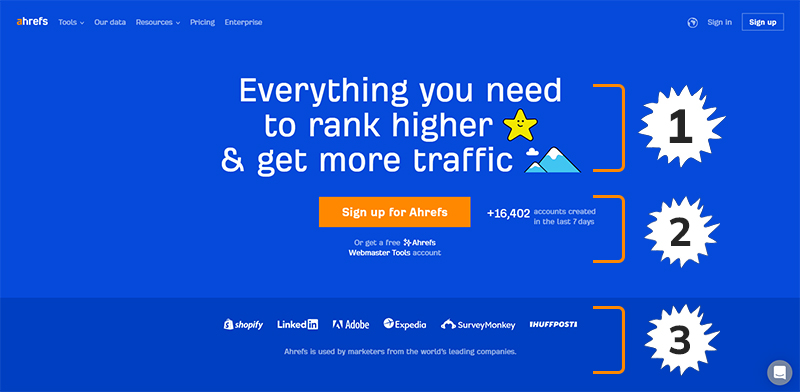
Ahrefs landing page is one of the best copywriting examples, as they have wonderfully divided their copy into several small sections demonstrating their service, and its key benefits, along with social proofs and also added the required CTAs.
4. Use short sentences
Whenever you read a long sentence, by the time you end reading it, you forget where you began. Long sentences thus puzzle and break the consistency of your reader. Write. Edit. Break. These three words make up the golden rule that every copywriter must adhere to. There are certain tips given by Danny Sheridan to write like an Amazonian that you can do to make your copy better.

Now let's look at an example of the website Simplified and how their content could have been broken into smaller sections to increase the readability of their landing page.
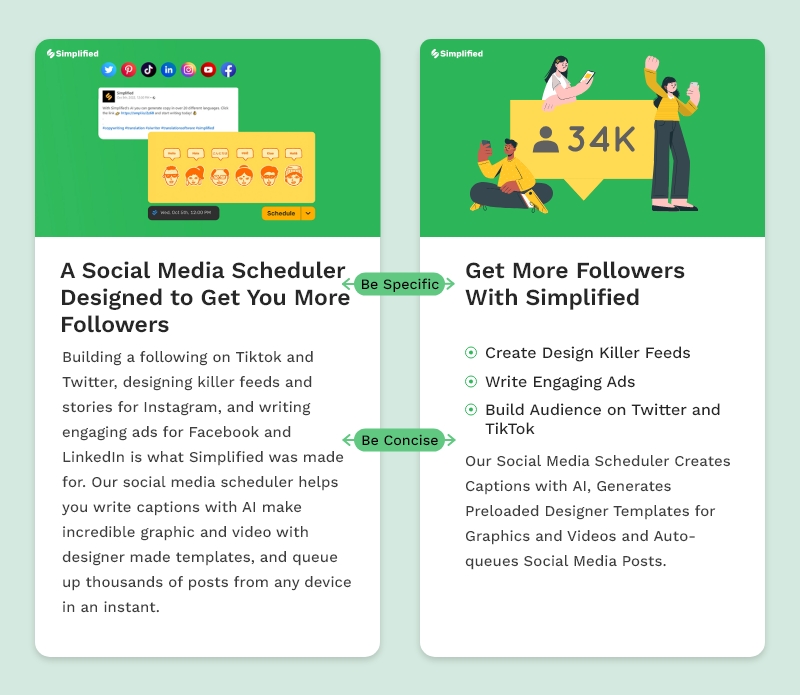
Now see on their landing page(on left), they have written the content in the paragraph where it could have simply been written in smaller points as shown on the right side of the image. Both sides deliver the same information, it is just that the content that is in pointers is easier for the audience to understand and read.
5. Use words that your reader understands
There is no denying the fact that it is the product or the service that should impress your customer, not the words you use to sell them. It means that whenever you are trying to communicate with your customer, you should use simple words rather than using pompous language or big words. The reason behind the same is that pompous language or big words at some point may impress the consumer but at the same time will annoy or even distract them from your main selling message. Rather than using words like unlock, unleash, enhance, empower, supercharge, etc. you can use simple words like improve, impress, better, greater, etc.

Moving ahead, here is a list of some simple words that you can use instead of big words.
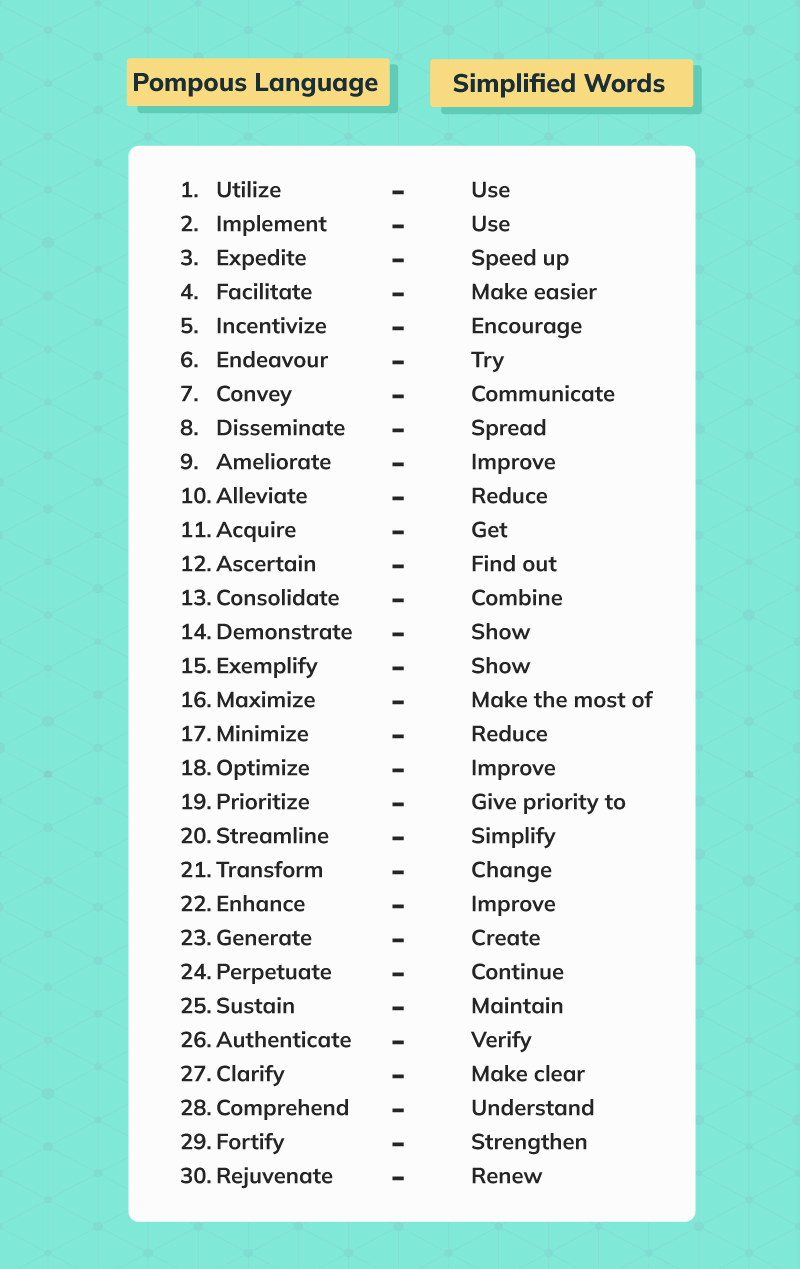
So, the clear message is that your words should portray what your customers like, what your customers need and how your customers talk.
6. Avoid technical jargon
While you are writing an ad copy or any form of content that relates to your customer, You should avoid any kind of technical jargon. Technical jargon often makes it difficult for the readers to comprehend and connect with the copy. Thus dilutes the whole agenda for creating an ad copy.
To avoid technical jargon, you should follow two simple rules.
- Use the language your customer uses: For example, when writing an ad copy for a phone, customers will better resonate with “10 hours of usage time with a single charge” rather than “packed with a 20000 MaH battery”. This example shows that customers in their daily life ask or talk or ask about how many hours a gadget works on a single charge and nobody talks about the specification of the battery pack. So, focus on using simple language that your users use on a daily basis.
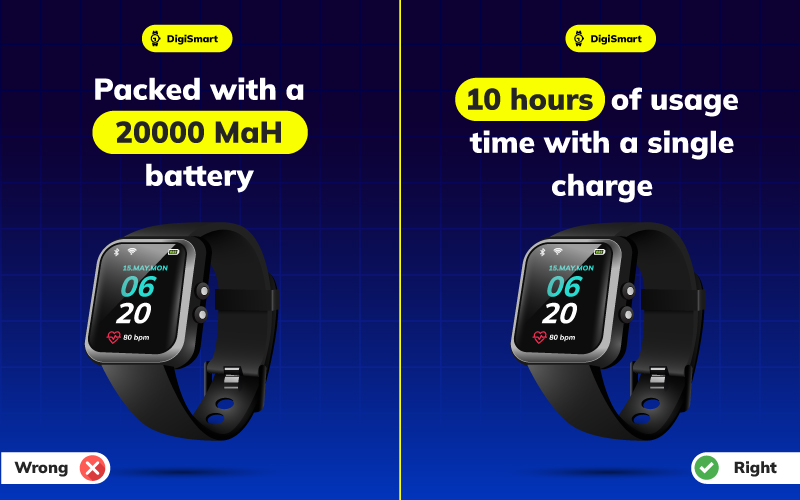
- Avoid technical terms or explain them wisely: Sometimes, it is essential for you to use technical words as there is no other alternative. In that case, you should prefer to use the simplest technical words and explain the meaning as well.
Now let's comprehend this with an example, let's assume that you are creating an ad copy for a car. Now in this ad copy, you can deliver the message by saying “0 to 100 miles in 5 seconds time” instead of saying that the car comes with a “2.4 liters turbocharged petrol engine that delivers 320 Nm Torque”. This helps deliver the message straight into the consumers' minds, and they will be able to resonate with the car power that you want to depict.
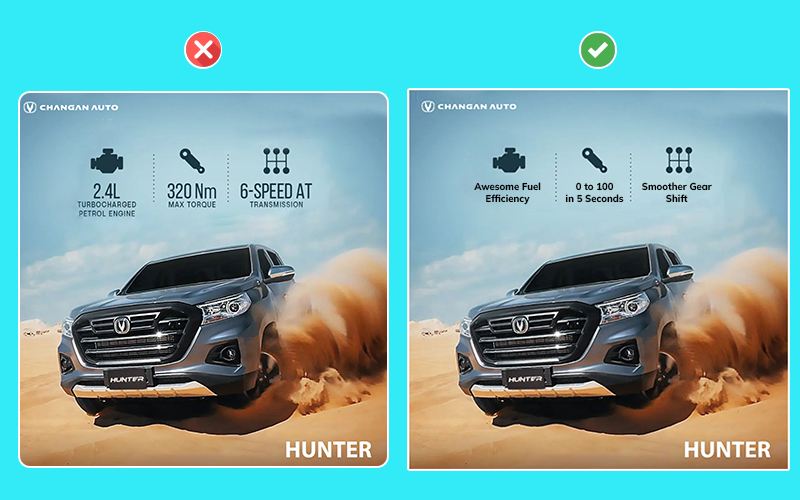
7. Use psychological and persuasion tactics
There are certain psychological principles and persuasion tactics that you can use throughout your copy. Robert B Cialdini, professor of psychology and marketing, in his book, Influence, has provided certain psychological principles that help users resonate which leads to an increase in sales. Let's look at a few of the principles one by one.
Principle 1: Social Proof
Social Proof - The psychological principle of social proof is very effective as people have a psychology that if a lot of people are doing something, that is the correct thing to do. This implies that when a lot of people are purchasing something or are even talking about something that thing makes it more believable. We daily see examples of this social proof used by marketers in different spaces. For example, to influence their audiences, Netflix provides a list of new and popular shows, Youtube provides a list of trending videos, and E-commerce platforms provide a list of the best selling. This sums up that consumers of the contemporary world tend to follow social proof and feel more socially accepted by being one of many.
Similarly, you can also do the same by adding social proof to your ad copy as shown below by using reviews, testimonials, or other forms of persuasive language depicting social proof like “4 out of 5 people are using our product” like the example given below.

Principle 2: Authority
People tend to follow the recommendations of someone who knows more than they know on the matter at hand. Whether it is a business decision to be made by an employee or a purchase decision to be made by a consumer. The human mind tends to pay obedience to more credible sources. For example, in any toothpaste ad, you will always see a pattern that every toothpaste is recommended by a number of dentists or doctors. Marketers in these kinds of advertisements use the authority principle and expect people to follow the notion of someone more credible such as a doctor.

Websites or e-commerce platforms use certain types of authoritative elements throughout their landing pages that can include sections such as those “recommended by”, a “list of their experts”, “as seen on” sections and others. The authority principle tends to increase the trust of consumers in your product but at the same time, should be used with caution as fake authoritativeness can also backfire on your marketing plan.
Principle 3: Scarcity
Less is best and the loss is worst. The scarcity principle tells us about human psychology that when something is less available or the opportunity to act on it will be lost, it makes it more valuable. Marketers and copywriters use this principle very frequently.
Apple utilizes this principle very often by creating a scarcity of their products in the initial launch days by keeping stocks of newly launched apple products limited. The queues outside the store make people think that whatever they are buying is very valuable. You can also use such tactics by using words that depict limited numbers and limited time which convince your readers that if they do not take action now they will lose something highly valuable.

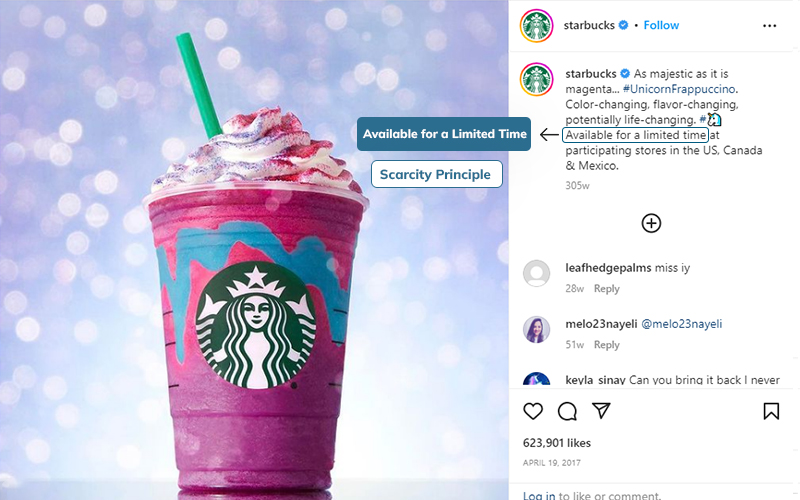
Bonus content
Seven questions every copywriter must answer before publishing - After writing your copy while editing you need to ask yourself seven questions.
Does my copy fulfill the promise of my headline?
- Is my copy relevant enough to generate enthusiasm?
- Can the reader read my copy without a dictionary?
- Is my copy persuasive?
- Will the customer believe in my copy?
- Is my copy relevant and concise?
- Does my copy call for action from the customer side?
- Does my copy have a consistent flow?
If your answer to all the questions is yes, your copy is good to go and you have taken our article seriously. If any of your questions have “No” as an answer, that calls for an action to read the article again. Moreover, if you think that all of this is too much to handle, you can simply contact us for getting high quality copywriting services.
FAQs
How can I measure the success of my copywriting efforts?
Use metrics such as conversion rates, click-through rates, sales, and engagement levels to measure the success of your copywriting efforts. Track the performance of different copies and conduct A/B tests to determine what resonates best with your audience.
How can I overcome writer's block when creating persuasive copy?
To overcome writer's block, take short breaks, do free writing exercises, research competitors' content, and seek inspiration from different sources. Exploring new perspectives and ideas can help you get back on track with your copywriting.

 Proof Reading
Proof Reading  Copy Writing
Copy Writing  Resume Writing
Resume Writing  Blogs
Blogs Guides
Guides SOP's
SOP's Student Resources
Student Resources Research Topics
Research Topics Login
Login Register
Register